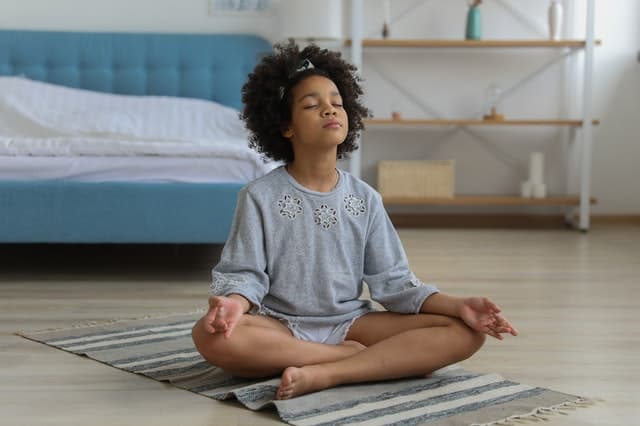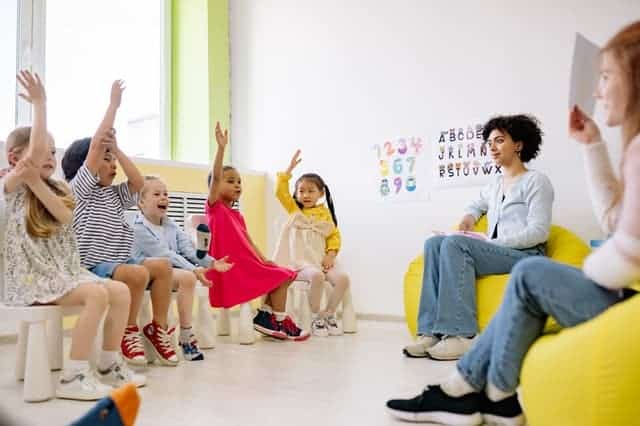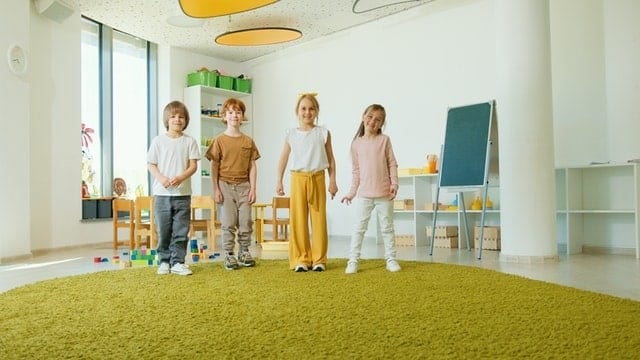When people think of mindfulness, they often think of meditation for adults. However, children can learn mindfulness with incredible emotional, physical, educational, and social benefits. In this article, we discuss the benefits of mindfulness for children and provide examples of mindfulness activities for the classroom.
What is Mindfulness

The practice of mindfulness was developed by Jon Kabat-Zinn over 30 years ago. This practice is also known as Mindful Based Stress Reduction (MBSR). It is defined as: “paying attention in a particular way: on purpose, in the present moment and non-judgmentally.” (Child Mind Institute) This mindfulness practice is well known for teaching children to focus on the present moment while easing anxiety.
Benefits of Mindfulness

The benefits of mindfulness in the classroom are vast. School environments may present stressful situations for children, both socially and academically. However, these stressors can be mitigated with mindfulness. Furthermore, studies have shown that learning mindfulness helps increase students’ focus, which helps them academically, while also helping them avoid negative behaviors (Harvard).
One study, conducted by researchers at the Boston Charter Research Collaborative, showed incredible promise. The researchers included staff from MIT, Harvard, and others. They studied 6th graders who learned mindfulness in an 8-week course. The results showed that the students who participated in the research study had lower stress, and were more able to focus and regulate their emotions. Brain scans also demonstrated that the part of the brain that responds to stress had responded less to stressful stimuli.
In a similar study, Stanford University studied students in 4th to 6th grade over 8 weeks of mindfulness training. They found that the participants had significant decreases in anxiety, and were less emotionally reactive. Additionally, students felt more able to handle challenges in their daily life, and also felt control over their behavior. Lastly, like the Harvard study, students had increased focus and experienced a sense of well-being (Child Mind Institute).
These results are so important because it shows that children thrive academically and emotionally when they are able to focus and be present. Reducing anxiety and stress increases students’ ability to focus and retain information, which is critical to their success. On a social-emotional level, children experience more acceptance and positive interactions with mindfulness. By avoiding negative behaviors and reactive emotions, their interactions with peers and teachers improve. This fosters a rich dynamic where students can grow academically, socially, and emotionally. Therefore, a mindfulness curriculum can play an important part in the classroom.
Mindfulness in the Classroom Activities

How can you teach mindfulness in the classroom? There are numerous ways to incorporate mindfulness activities. Many of them take 5 minutes or less and provide an excellent start to each students’ day. Here are some mindfulness in the classroom activities you can incorporate into your classroom:
1. Guided Meditation
This is surprisingly easy with apps that do the work for you. Have students sit or lie down with the lights dimmed, and encourage all students to participate in a guided meditation. If students do not want to participate, simply have them sit quietly. Praise the students who did the activity and ease back into the classroom setting by discussing how they feel afterward (VeryWellMind).
2. Guided Activities
One example of a guided activity is to have students mindfully eat a raisin or piece of fruit (Vanderbilt). Students can touch, look at, and chew a raisin for a full 5-10 minutes. This activity encourages self-awareness and increases their attention span. Additionally, this activity can teach children to slow down and appreciate life moment to moment. Students can journal afterward about the experience or discuss it in a large group.
3. Journal Writing
This activity is appropriate for children ages 6 and up. However, younger children can draw pictures instead. Appropriate writing prompts can include questions such as: what are three beautiful things you heard today? Or, what are three urges you resisted today? For older students, these prompts can become even more thought-provoking and challenging to get them thinking introspectively. (Positive Psychology).
4. Mindful Breathing
Teaching students breathing techniques is another great way to teach mindfulness. Helping students to focus on their breathing is an important technique for stress reduction. Students can sit or stand, and inhale air through the nose for 3 seconds, hold for 2, and exhale for 4 out of the mouth. For best results, it is important that students stay focused and aware of their breath and how they feel during the exercise (Berkeley).
5. Mindful Body Scan
In this activity, students should either sit or lie down. This activity begins with focusing on breathing to relax. Then, students are asked to relax their bodies bit by bit. Instruct them to start at their feet and move upwards slowly to their head, until every part of their body is relaxed. It requires concentration and commitment, and rewards students with deep relaxation while providing relief from stress and anxiety. (University of Minnesota).
Vary mindfulness activities to help students stay engaged and focused.
Mindfulness curriculum does not have to take long—in fact, just 5-10 minutes a day. The time spent on these activities is often returned, as student behaviors and focus are improved. Less time is needed to address behavioral issues. This allows the teacher to teach and the students to learn. By providing mindfulness in the classroom, we empower children to be successful socially, emotionally, and academically. That is worth a few minutes each day!
Soul Shoppe provides social emotional learning programs, including SEL programs for elementary schools, and programs on mindfulness, inclusivity, allyship, conflict resolution strategies for students, and more.
You May Also Like:
Sources:
Child Mind Institute, Harvard, HelpGuide Harvard, Positive Psychology, Stanford, University of Minnesota, Vanderbilt, VeryWellMind


